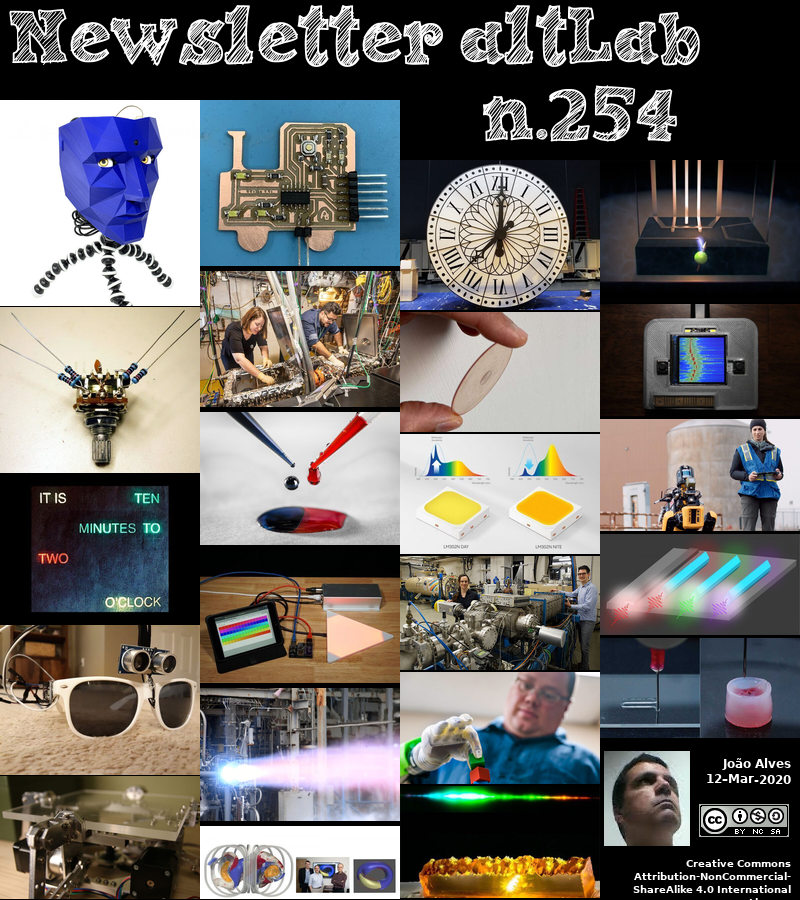2020-03-12 - Nº 254
Editorial
Esta é a Newsletter Nº 254 que se apresenta com o mesmo formato que as anteriores. Se gostar da Newsletter partilhe-a!
Todas as Newsletters encontram-se indexadas no link.
Esta Newsletter tem os seguintes tópicos:
Faz anos hoje que nascia, em 1790 o quimico inglês John Frederic Daniell. Ele foi responsável pela invenção da célula Daniell, que foi uma grande melhoria em relação à célula voltaica usada nos primeiros dias do desenvolvimento da bateria. A sua pesquisa em 1820 levou à invenção de um higrómetro que media a humidade relativa que posteriormente se tornou um instrumento padrão. Daniell iniciou experiências em 1835, na tentativa de melhorar a bateria voltaica com seu problema de ser instável e como uma fonte fraca de corrente eléctrica. Em 1836, ele inventou uma célula primária na qual o hidrogénio foi eliminado com a geração da electricidade. Daniell tinha resolvido o problema da polarização devido a uma fina película de bolhas de hidrogénio que se formava sobre o eléctrodo positivo que reduzia a corrente.
Faz também anos hoje que nascia, em 1824, o físico alemão Gustav Kirchhoff. Ele juntamente com Robert Bunsen, estabeleceu a teoria da análise de espectro (uma técnica para análise química, analisando a luz emitida por um material aquecido), aplicada por Kirchhoff para determinar a composição do Sol. Ele descobriu que quando a luz passa através de um gás, o gás absorve os comprimentos de onda que seriam emitidos se aquecidos, o que explicava as numerosas linhas escuras (linhas de Fraunhofer) no espectro do Sol. Nas leis de Kirchhoff (1845), ele generalizou as equações que descrevem o fluxo de corrente no caso dos condutores eléctricos em três dimensões, estendendo a lei de Ohm ao cálculo das correntes, tensões e resistências das redes eléctricas. Ele demonstrou que a corrente flui num condutor de resistência zero à velocidade da luz.
Faz igualmente anos hoje que nascia, em 1838, o químico inglês William Henry Perkin. Enquanto experimentava sintetizar o quinino a partir de um produto químico do alcatrão de carvão, Perkins misturou anilina e dicromato de sódio e inesperadamente encontrou uma cor densa - que ele denominou roxo anilina - que extraiu com álcool. Ele descobrira o primeiro corante artificial. Os têxteis da sua época eram coloridos de fontes naturais; a dele era uma alternativa valiosa. Aos 18 anos, ele patenteou o corante. O seu pai investiu em seus esforços para fabricar o corante. Foi colocado à venda em 1857 e tornou-se popular na França. Aos 23 anos, ele era pai de uma nova indústria química orgânica sintética.
Faz também anos hoje que nascia, em 1905, o engenheiro electrotécnico norte-americano Chauncey Guy Suits. Ele ajudou a desenvolver um novo processo, anunciado em 1962, para criar diamantes sintéticos comprimindo carbono numa grande prensa hidráulica a pressões de até três milhões de libras por polegada quadrada, enquanto simultaneamente aquecido a 9.000 ºF, sem a necessidade do agente catalisador de metal usado anteriormente. Ele possuía 77 patentes nos EUA, em aplicações variadas, como melhorias de sinal de bloqueio ferroviário, circuitos para sinais eléctricos que piscam em sequência, circuitos de rádio, sinalizadores, sinais submarinos, redutores de luz de teatro e relés fotoeléctricos.
Por fim, faz anos hoje que nascia, em 1925, o físico japonês Leo Esaki. Ele partilhou (com Ivar Giaever e Brian Josephson) o Prémio Nobel de Física (1973) em reconhecimento pelo seu trabalho pioneiro em tunelamento de electrões em sólidos. A partir de algumas experiências aparentemente simples publicadas em 1958, ele foi capaz de desvendar os processos de tunelamento em sólidos, um fenómeno que estava coberto de perguntas por décadas. O tunelamento é um efeito mecânico quântico no qual um electrão passa através de uma barreira em potencial, embora a teoria clássica previsse que não poderia. A descoberta do Dr. Esaki levou à criação do díodo Esaki, um componente importante da física do estado sólido com aplicações práticas em circuitos de alta velocidade encontrados em computadores e redes de comunicações.
E nesta semana que passou o tema dominante foi o COVID-19, nome dado a doença provocada por uma estirpe de coronavirus (SARS-CoV-2) descoberta em final de 2019 e que teve origem em Wuhan na China. Até agora tinha sido uma doença que afectava o mundo mas à qual Portugal tinha ficado de fora não sofrendo (de forma muito visível) os efeitos que outros países já estavam a sofrer. Mas esta semana deixou de ser uma doença que afecta os outros e passou a afectar o nosso quotidiano. Tendo passado à categoria de pandemia significa que todos os países estão em risco. E é particularmente importante que cada um de nós contribua activamente para o controlo desta doença seguindo os conselhos da OMS evitando locais com densidade elevada de pessoas, deslocações desnecessárias, lavar as mãos com frequência, evitar cumprimentos próximos como apertos de mão ou beijinhos, evitar tocar com as mãos nos seus olhos, boca ou nariz, e usar o bom senso nas compras de bens evitando o desperdício.
Na Newsletter desta semana apresentamos diversos projetos de maker.
 João Alves ([email protected])
João Alves ([email protected])
O conteúdo da Newsletter encontra-se sob a licença  Creative Commons Attribution-NonCommercial-ShareAlike 4.0 International License.
Creative Commons Attribution-NonCommercial-ShareAlike 4.0 International License.
Outras Notícias

3D-printed thrust chamber passes first tests for Vega evolutions
"The 3D-printed thrust chamber assembly of the methane-fuelled M10 rocket engine has passed its first series of hot firing tests. The M10 engine will power the upper stage of future Vega evolutions from 2025. “These test results are encouraging, confirming that our propulsion teams are right on track along the development path identified for such novel technology for Vega evolutions,” commented Giorgio Tumino, managing ESA’s Vega and Space Rider development programmes. M10 will improve propulsion efficiency and environmental sustainability by reducing emissions and combustion waste thereby increasing the competitiveness of European small launchers and lowering their cost. The M10 is restartable and uses a system of smart pressure control. This improves fuel management and offers mission flexibility." [...]

STMicroelectronics Introduces STM32L4+ Microcontrollers for Power- and Cost-Sensitive Smart Embedded Applications
"New STM32L4P5 and STM32L4Q5 microcontrollers (MCUs) from STMicroelectronics bring the performance of the Arm® Cortex®-M4 core to cost-sensitive and power-conscious smart connected devices, including utility meters, industrial and medical sensors, fitness trackers, and smart-home products. With memory density down to 512KB Flash and 320KB SRAM, ST’s new STM32L4+ MCUs deliver performance with economy. Compact 10mm x 10mm 64-pin and 7mm x 7mm 48-pin package options let designers tackle applications limited by size constraints such as wearable form factors. Flexibility is assured, with independent power connections for circuitry such as USB and analog peripherals, independent clock domains, and Octal and Quad SPI interfaces for external memory expansion. The new devices also feature a 5Msample/s smart analog-to-digital converter (ADC) that can operate at full speed to minimize acquisition time, or at reduced speed with lower current. Leveraging ST’s ultra-low-power microcontroller technologies, the new STM32L4+ MCUs feature seven main low-power modes that let designers creatively manage power consumption and wake-up times to minimize energy demand." [...]
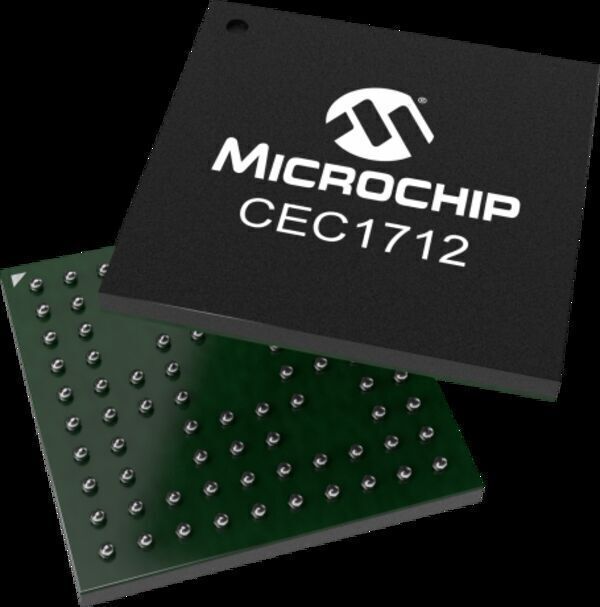
Protect Against Rootkit and Bootkit Malware in Systems that Boot from External SPI Flash Memory
"Microchip’s new cryptographic MCU, custom firmware and provisioning service are designed to enable platforms to detect and stop malicious firmware prior to run time With the rapid growth of 5G including new cellular infrastructure, growing networks and data centers supporting expanding cloud computing, developers are seeking new ways to ensure operating systems remain secure and uncompromised. Microchip Technology Inc. (Nasdaq: MCHP) today announced a new cryptography-enabled microcontroller (MCU), the CEC1712 MCU with Soteria-G2 custom firmware – designed to stop malicious malware such as rootkit and bootkit for systems that boot from external Serial Peripheral Interface (SPI) flash memory. Microchip’s Soteria-G2 custom firmware on its full-featured CEC1712 Arm® Cortex®-M4-based microcontroller provides secure boot with hardware root of trust protection in a pre-boot mode for those operating systems booting from external SPI flash memory. In addition, the CEC1712 provides key revocation and code rollback protection during operating life enabling in-field security updates. Complying with NIST 800-193 guidelines, the CEC1712 protects, detects and recovers from corruption for total system platform firmware resiliency. The secure boot with hardware root of trust is critical in protecting the system against threats before they can load into the system and only allows the system to boot using software trusted by the manufacturer." [...]
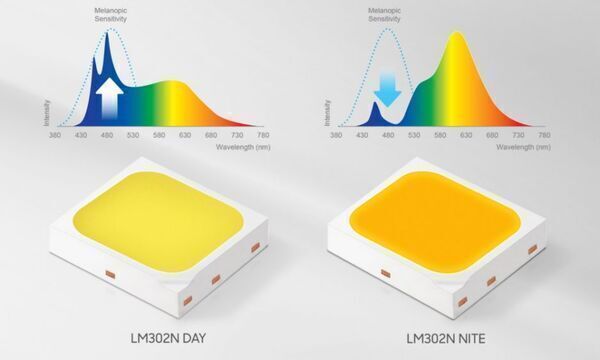
Samsung Electronics Unveils Its First Family of 'Human-Centric' LED Components to Enhance Indoor Lifestyles
"Samsung Electronics, a world leader in advanced digital component solutions, today unveiled its first “human-centric” LED packages, collectively known as LM302N. Engineered with carefully created light spectra, the LM302N family helps human bodies adjust melatonin levels indoors, making people feel more energetic or relaxed depending on their daily life patterns. “The benefits of using Samsung’s LM302N reach beyond the basic lighting function of visual recognition, by improving the non-visual biological effects of lighting on people,” said Un Soo Kim, senior vice president of LED Business Team at Samsung Electronics. “Our LED solutions are ushering in a whole new human-oriented approach of using artificial lighting to enhance productivity and relaxation, benefitting modern-day indoor lifestyles.” Melatonin, a hormone which regulates the sleep-wake cycle, responds to the cyan wavelength range of light. Brighter cyan-concentrated lighting suppresses the body’s production of melatonin, increasing concentration and enabling a greater overall sense of alertness. Similarly, a lower cyan light intensity minimizes disturbances to the natural onset of the body’s melatonin production, helping to promote sleep quality." [...]
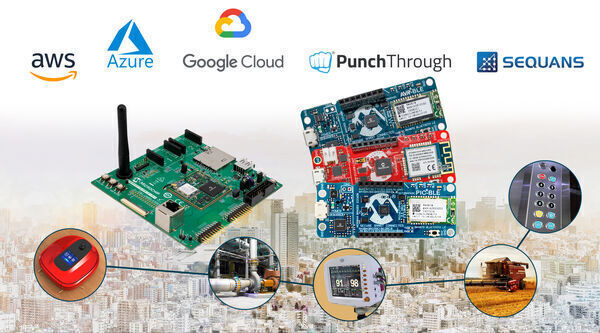
Enabling Cloud Connectivity to All MCUs and MPUs, Microchip Launches a Range of Embedded IoT Solutions for Rapid Prototyping
"When designing IoT solutions, developers can quickly, easily and securely connect to any cloud using Wi-Fi, Bluetooth and narrow band 5G technologies Due to the fragmented nature of the Internet of Things (IoT) marketplace, increasing project complexity and costs, today’s developers face more challenges in design decisions than ever before. These challenges lead to extended development times, increased security threats and failed solutions. Continuing to execute upon its core strategy of delivering smart, connected and secure systems, Microchip Technology Inc. (Nasdaq: MCHP) today announced its cloud agnostic, turnkey, full-stack embedded development solutions. From the smallest PIC® and AVR® microcontrollers (MCUs) for sensors and actuator devices, to the most sophisticated 32-bit MCU and microprocessor (MPU) gateway solutions for edge computing, the company is now making it possible for developers to connect to any major core and any major cloud, using Wi-Fi®, Bluetooth® or narrow band 5G technologies – all while maintaining a strong security foundation through the support of its Trust Platform for the CryptoAuthentication™ family. Microchip’s already broad portfolio of IoT solutions now includes six additional solutions. Making their core, connectivity, security, development environment and debug capabilities easily accessible, all are designed to lower project costs and complexity in development: PIC-IoT WA and AVR-IoT WA boards: Two new PIC and AVR MCU development boards with a companion custom built rapid prototyping tool developed in collaboration with Amazon Web Services (AWS), helping designers natively connect IoT sensor nodes to the AWS IoT Core service via Wi-Fi Gateway solutions running AWS IoT Greengrass: Based on the latest wireless System On Module (SOM), the ATSAMA5D27-WLSOM1 integrates the SAMA5D2 MPU, WILC3000 Wi-Fi and Bluetooth combo module fully powered by the MCP16502 high performance Power Management IC (PMIC) SAM-IoT WG: Connects the Google Cloud IoT Core with Microchip’s popular 32-bit SAM-D21 Arm® Cortex® M0+ range of microcontrollers Azure IoT SAM MCU based IoT development platform: Integrates the Azure IoT device SDK and Azure IoT services with Microchip’s MPLAB® X development tools ecosystem PIC-BLE and AVR-BLE boards: Two new PIC and AVR MCU boards for sensor node devices that connect to mobile devices for industrial, consumer and security applications and the cloud via gateways featuring Bluetooth Low Energy (BLE) LTE-M/NB-IoT development kit: Features Monarch chip-based modules by Sequans enabling coverage of IoT nodes and leveraging the latest low power, 5G cellular technology “Microchip is building on its already comprehensive portfolio of tools and solutions to enable quick, easy development of secure IoT applications across the full spectrum of embedded control devices and architectures,” said Greg Robinson, associate vice president of marketing for Microchip’s 8-bit microcontroller business unit." [...]
Ciência e Tecnologia
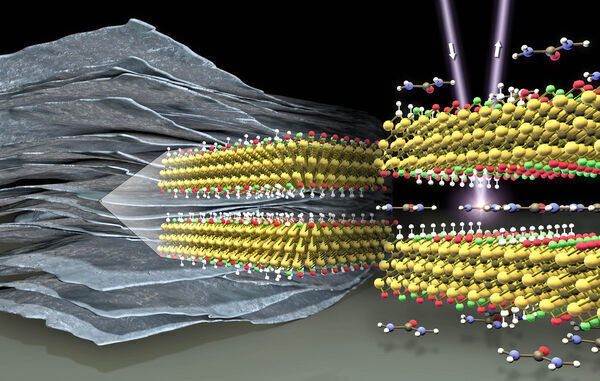
Fast and furious: New class of 2D materials stores electrical energy
"Two dimensional titanium carbides, so-called MXenes, are being discussed as candidates for the rapid storage of electrical energy. Like a battery,MXenes can store large amounts of electrical energy through electrochemical reactions- but unlike batteries,can be charged and discharged in a matter of seconds. In collaboration with Drexel University, a team at HZB showed that the intercalation of urea molecules between the MXene layers can increase the capacity of such "pseudo-capacitors" by more than 50 percent. At BESSY II they have analysed how changes of the MXene surface chemistry after urea intercalation are responsible for this. There are different solutions for storing electrical energy: Lithium-based electrochemical batteries, for example, store large amounts of energy, but require long charging times. Supercapacitors, on the other hand, are able to absorb or release electrical energy extremely quickly - but store much less electrical energy." [...]
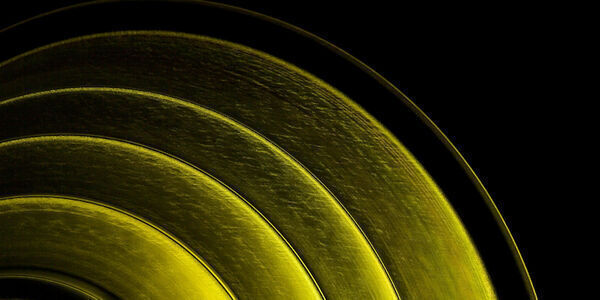
Breakthrough magnet produced from sustainable materials
"Scientists have made a breakthrough in the search for a new, sustainable permanent magnet. Most permanent magnets are made from alloys of rare earth metals - but the mining and processing of these materials produces toxic by-products, leading to ecological challenges around rare-earth mines and refineries. At the same time, demand for permanent magnets is increasing as they are a common component in renewable energy, consumer electronics and electric-powered vehicles. A team of scientists, led by the University of Leeds, has made a breakthrough in a new advanced material which may eventually replace rare-earth-based permanent magnets. The researchers have developed a hybrid film from a thin layer of cobalt, which is naturally magnetic, covered with molecules of Buckminsterfullerene, a form of carbon. The presence of the carbon dramatically boosted cobalt’s magnetic energy product, a measure of the strength of a magnet, by five times at low temperatures." [...]

First bufferless 1.5 μm III-V lasers grown directly on silicon wafers in Si-photonics
"Researchers from the Hong Kong University of Science and Technology (HKUST) have reported the world's first 1.5 μm III-V lasers directly grown on the industry-standard 220 nm SOI (silicon-on-insulators) wafers without buffer, potentially paving an opening to the "holy grail" for present silicon (Si-) photonics research. Seamlessly bridging the active III-V light sources with the passive Si-based photonic devices, the demonstration could be deployed as light sources in integrated circuits to greatly improve circuit speed, power efficiency and cost-effectiveness. In other conventional approaches of integrating III-V lasers on Si in the literature, thick III-V buffers up to a few micrometers are used to reduce the defect densities, which posts huge challenges for efficient light interfacing between the epitaxial III-V lasers and the Si-based waveguides. For the first time in history, the research team led by Prof. LAU Kei-May of HKUST's Department of Electronic and Computer Engineering and Post-doctoral Fellow Dr. HAN Yu devised a novel growth scheme to eliminate the requirement of thick III-V buffers and thus promoted efficient light coupling into the Si-waveguides. The bufferless feature points to a fully integrated Si-based photonic integrated circuits. That has enabled the first demonstration of 1.5 μm III-V lasers directly grown on the industry-standard 220 nm SOI wafers using metal organic chemical vapor deposition (MOCVD)." [...]

The Unfoldable Bridge
"A world premiere in Austria: The new bridge construction technology which was developed at TU Wien has now been successfully applied by ASFINAG during the construction of the Fürstenfeld Motorway There are many different methods for erecting bridges – but the new technique developed by TU Wien, the balanced lowering method, is quite spectacular: the bridge is not built horizontally, as would normally be case, but erected in a vertical position and then rotated into the horizontal position. The first large scale tests were carried out in 2010, since then the method has been refined and tuned until finally finding its first application by the ASFINAG for two bridges of the Fürstenfeld Motorway S7. With the erection process successfully completed for the Lahnbach Bridge, the 116 m long bridge over the Lafnitz was “unfolded” on the 27th of February 2020. With no scaffolding needed this new bridge construction method not only saves time but also money and resources. The umbrella principle “Depending on the size and location a variety of bridge building techniques are applied nowadays,” Prof. Johann Kollegger of the Institute of Structural Engineering of TU Wien explains. If the bridge is not too high from the ground it can be erected using scaffolding." [...]
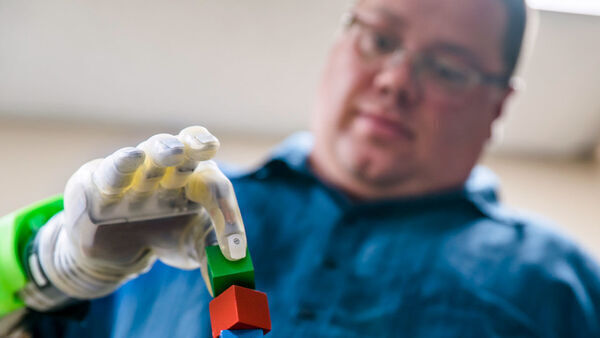
Minimuscles let amputees control a robot hand with their minds
"Building a beautiful robotic hand is one thing. Getting it to do your bidding is another. For all the hand-shaped prostheses designed to bend each intricate joint on cue, there’s still the problem of how to send that cue from the wearer’s brain. Now, by tapping into signals from nerves in the arm, researchers have enabled amputees to precisely control a robotic hand just by thinking about their intended finger movements. The interface, which relies on a set of tiny muscle grafts to amplify a user’s nerve signals, just passed its first test in people: It translated those signals into movements, and its accuracy stayed stable over time. “This is really quite a promising and lovely piece of work,” says Gregory Clark, a neural engineer at the University of Utah who was not involved in the research." [...]
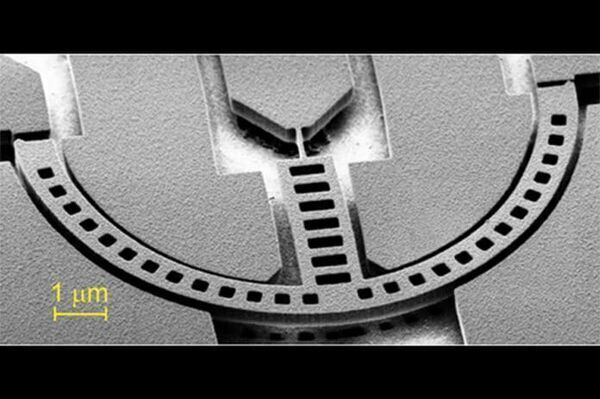
Bristol discovery is significant step toward developing electronics for extreme energy efficiency
"Researchers at the University of Bristol have come up with a new type of nanoelectromechanical relay to enable reliable, high-temperature, non-volatile memory. The work, which is reported in Nature Communications, was carried out in collaboration with the University of Southampton and the Royal Institute of Technology, Sweden. The invention is an important development for all-electric vehicles and more-electric aircraft which require electronics with integrated data storage that can operate in extreme temperatures with high energy efficiency. As transistor leakage current increases with temperature, nanoelectromechanical relays have emerged as a promising alternative to transistors for such applications. However, until now, a reliable and scalable non-volatile relay that retains its state when powered off, to implement memory, has not been demonstrated. Dr Dinesh Pamunuwa, who leads a group that carries out research in the field of Microelectronics at the University of Bristol and is the lead investigator, explains: “Part of the challenge is the way electromechanical relays operate; when actuated, a beam anchored at one end moves under an electrostatic force." [...]
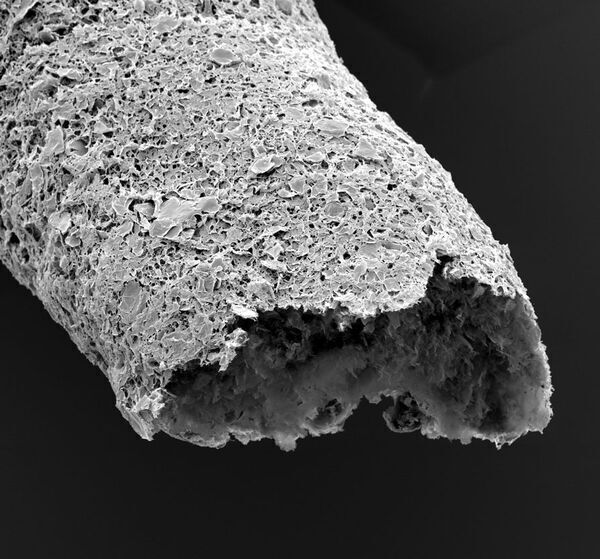
Biomaterial discovery enables 3D printing of tissue-like vascular structures
"An international team of scientists have discovered a new material that can be 3D printed to create tissue-like vascular structures. In a new study published today in Nature Communications, led by Professor Alvaro Mata at the University of Nottingham and Queen Mary University London, researchers have developed a way to 3D print graphene oxide with a protein which can organise into tubular structures that replicate some properties of vascular tissue. Professor Mata said: “This work offers opportunities in biofabrication by enabling simulatenous top-down 3D bioprinting and bottom-up self-assembly of synthetic and biological components in an orderly manner from the nanoscale. Here, we are biofabricating micro-scale capillary-like fluidic structures that are compatible with cells, exhibit physiologically relevant properties, and have the capacity to withstand flow." This could enable the recreation of vasculature in the lab and have implications in the development of safer and more efficient drugs, meaning treatments could potentially reach patients much more quickly. Professor Alvaro Mata Material with remarkable properties Self-assembly is the process by which multiple components can organise into larger well-defined structures." [...]
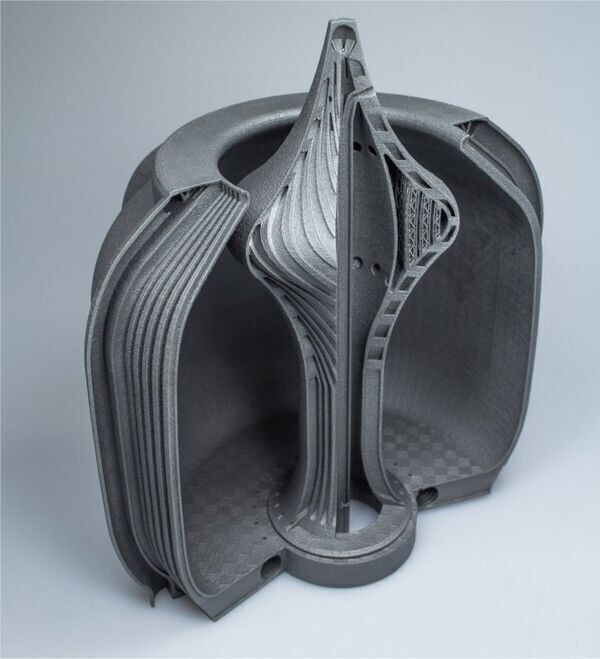
Additively manufactured rocket engine features an aerospike nozzle for microlaunchers
"Microlaunchers are an alternative to conventional launch vehicles. Able to carry payloads of up to 350 kilograms, these midsized transport systems are designed to launch small satellites into space. Researchers at the Fraunhofer Institute for Material and Beam Technology IWS in Dresden and TU Dresden’s aerospace experts developed an additively manufactured rocket engine with an aerospike nozzle for microlaunchers. The scaled metal prototype is expected to consume 30 percent less fuel than conventional engines. It will feature prominently at the Hannover Messe Preview on February 12 and in the showcase at booth C18 in hall 16 at the Hannover Messe from April 20 through 24, 2020. The market for small satellites is sure to boom in the years ahead." [...]

Innovative Switching Mechanism Improves Ultrafast Control of Microlasers
"New mechanism breaks the long-standing limitation of all-optical switch for optical and quantum computing All-optical switch is the fundamental building block of optical communications, optical computing, as well as quantum information. An innovative approach utilizing the far field characteristics of topologically protected bounded states in the continuum is able to break the long-standing trade-off between ultrashort switching time and ultralow energy consumption. The advance could lead to an efficient ultrafast all-optical switch, and eventually revolutionize the all-optical computing. All-optical switch is a kind of device that controls light by light, which is the fundamental building block of modern optical communications and information processing. Creating an efficient, ultrafast, and compact all-optical switch has been recognized as the key step for the developments of next-generation optical and quantum computing. In principle, photons don’t interact one another directly in the low power linear regime, and a cavity is usually needed to resonantly enhance the field of control light and increase the interaction." [...]

Terahertz radiation technique opens a new door for studying atomic behavior
"Researchers have squeezed a high-energy electron beam into tight bundles using terahertz radiation, a promising advance in watching the ultrafast world of atoms unfold. Researchers from the Department of Energy’s SLAC National Accelerator Laboratory have made a promising new advance for the lab’s high-speed “electron camera” that could allow them to “film” tiny, ultrafast motions of protons and electrons in chemical reactions that have never been seen before. Such “movies” could eventually help scientists design more efficient chemical processes, invent next-generation materials with new properties, develop drugs to fight disease and more. The new technique takes advantage of a form of light called terahertz radiation, instead of the usual radio-frequency radiation, to manipulate the beams of electrons the instrument uses. This lets researchers control how fast the camera takes snapshots and, at the same time, reduces a pesky effect called timing jitter, which prevents researchers from accurately recording the timeline of how atoms or molecules change. The method could also lead to smaller particle accelerators: Because the wavelengths of terahertz radiation are about a hundred times smaller than those of radio waves, instruments using terahertz radiation could be more compact." [...]

Novel method for easier scaling of quantum devices
"System “recruits” defects that usually cause disruptions, using them to instead carry out quantum operations. In an advance that may help researchers scale up quantum devices, an MIT team has developed a method to “recruit” neighboring quantum bits made of nanoscale defects in diamond, so that instead of causing disruptions they help carry out quantum operations. Quantum devices perform operations using quantum bits, called “qubits,” that can represent the two states corresponding to classic binary bits — a 0 or 1 — or a “quantum superposition” of both states simultaneously. The unique superposition state can enable quantum computers to solve problems that are practically impossible for classical computers, potentially spurring breakthroughs in biosensing, neuroimaging, machine learning, and other applications. One promising qubit candidate is a defect in diamond, called a nitrogen-vacancy (NV) center, which holds electrons that can be manipulated by light and microwaves. In response, the defect emits photons that can carry quantum information." [...]
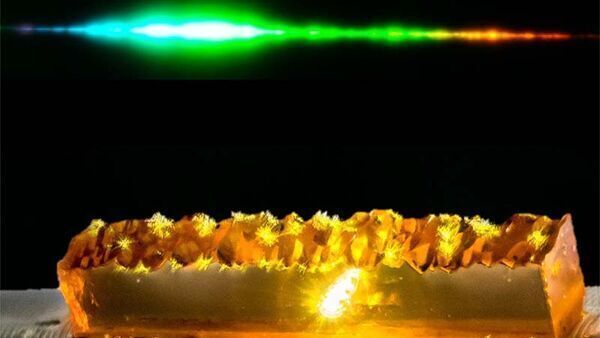
Crystal creates a supercontinuum breakthrough
"Researchers have generated a wide range of colours from a single laser after discovering a new process for achieving so-called ‘supercontinuum generation’. Supercontinuum generation is when intense laser light of one colour travels within a material, like glass, and broadens into a spectrum of colours. The effect lets scientists produce light at colours tailored to particular applications in sectors like bioimaging, optical communications and fundamental studies of materials. Until now, there were two ways to create a supercontinuum. A special optical fibre, around 10% of the width of a human hair, could be used to concentrate light to a very high intensity, over lengths of a few metres. Alternatively, even more powerful light from an amplified laser—of the kind invented by the 2019 Nobel Laureates Strickland and Mourou—could be tightly focused into ordinary glass." [...]
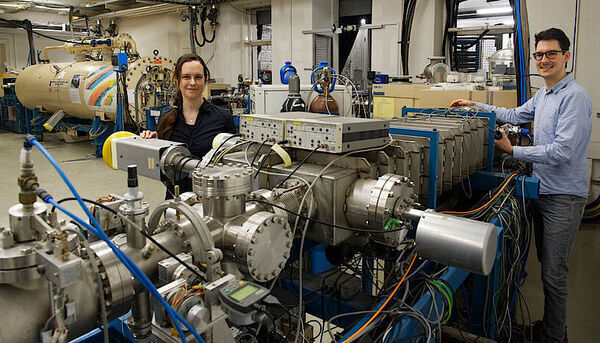
Atomic fingerprint identifies emission sources of uranium
"Uranium is not always the same: depending on whether this chemical element is released by the civil nuclear industry or as fallout from nuclear weapon tests, the ratio of the two anthropogenic, i.e. man-made, uranium isotopes 233U and 236U varies. These results were lately found by an international team grouped around physicists from the University of Vienna and provides a promising new "fingerprint" for the identification of radioactive emission sources. As a consequence, it is also an excellent environmental tracer for ocean currents, as it is shown in Nature Communications. The oceans naturally contain concentrations of the element uranium (U) in the range of several micrograms per kilogram of water. Due to its dissolved chemical form, uranium is not removed from water by sedimentation, but is transported and mixed together with the corresponding water masses." [...]

Robots Autonomously Navigate Underground in DARPA Challenge
"Whether robots are exploring caves on other planets or disaster areas here on Earth, autonomy enables them to navigate extreme environments without human guidance or access to GPS. The Subterranean Challenge, or SubT, is testing this kind of cutting-edge technology. Sponsored by the Defense Advanced Research Projects Agency (DARPA), the contest concluded its second circuit on Wednesday, Feb. 27. Taking first in the competition was CoSTAR, a 12-robot, 60-person team led by NASA's Jet Propulsion Laboratory (there were also winners declared for a separate, virtual competition). SubT is divided into four circuits spread over three years. With each, teams program their robots to navigate a complex underground course." [...]

The ink of the future in printed electronics
"A research group led by Simone Fabiano at the Laboratory of Organic Electronics, has created an organic material with superb conductivity that doesn’t need to be doped. They have achieved this by mixing two polymers with different properties. In order to increase the conductivity of polymers, and in this way obtain higher efficiency in organic solar cells, light-emitting diodes and other bioelectronic applications, researchers have until now doped the material with various substances. Typically, this is done by either removing an electron or donating it to the semiconductor material with a dopant molecule, a strategy that increases the number of charges and thereby the conductivity of the material. “We normally dope our organic polymers to improve their conductivity and the device performance. The process is stable for a while, but the material degenerates and the substances we use as doping agents can eventually leach out." [...]
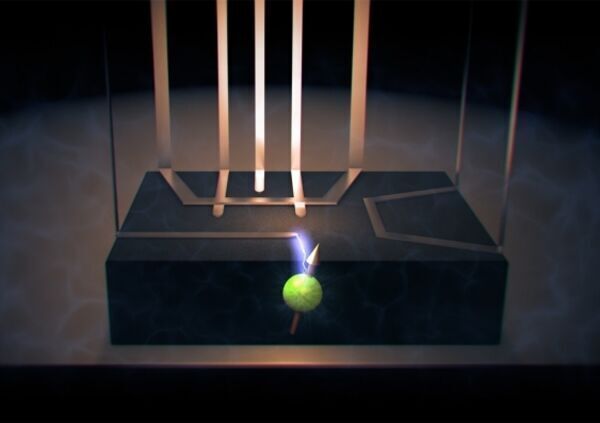
Engineers crack 58-year-old puzzle on way to quantum breakthrough
"A mishap during an experiment led UNSW quantum computing researchers to crack a mystery that had stood since 1961. A happy accident in the laboratory has led to a breakthrough discovery that not only solved a problem that stood for more than half a century, but has major implications for the development of quantum computers and sensors. In a study published today in Nature, a team of engineers at UNSW Sydney has done what a celebrated scientist first suggested in 1961 was possible, but has eluded everyone since: controlling the nucleus of a single atom using only electric fields. “This discovery means that we now have a pathway to build quantum computers using single-atom spins without the need for any oscillating magnetic field for their operation,” says UNSW’s Scientia Professor of Quantum Engineering Andrea Morello. “Moreover, we can use these nuclei as exquisitely precise sensors of electric and magnetic fields, or to answer fundamental questions in quantum science.” That a nuclear spin can be controlled with electric, instead of magnetic fields, has far-reaching consequences. Generating magnetic fields requires large coils and high currents, while the laws of physics dictate that it is difficult to confine magnetic fields to very small spaces – they tend to have a wide area of influence." [...]
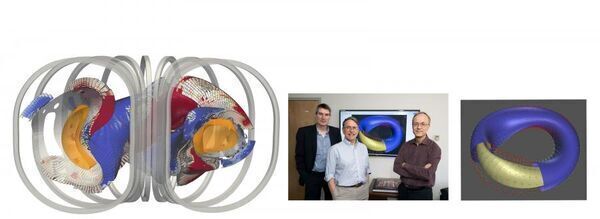
Permanent magnets akin to those on fridges could speed the development of fusion energy
"Permanent magnets akin to those used on refrigerators could speed the development of fusion energy – the same energy produced by the sun and stars. In principle, such magnets can greatly simplify the design and production of twisty fusion facilities called stellarators, according to scientists at the U.S. Department of Energy’s (DOE) Princeton Plasma Physics Laboratory (PPPL) and the Max Planck Institute for Plasma Physics in Greifswald, Germany. PPPL founder Lyman Spitzer Jr. invented the stellarator in the early 1950s. Most stellarators use a set of complex twisted coils that spiral like stripes on a candy cane to produce magnetic fields that shape and control the plasma that fuels fusion reactions. Refrigerator-like permanent magnets could produce the hard part of these essential fields, the researchers say, allowing simple, non-twisted coils to produce the remaining part in place of the complex coils. Twisted coils most expensive “The twisted coils are the most expensive and complicated part of the stellarator and have to be manufactured to very great precision in a very complicated form,” said physicist Per Helander, head of the Stellarator Theory Division at Max Planck and lead author of a paper describing the research(link is external) in Physical Review Letters (PRL)." [...]
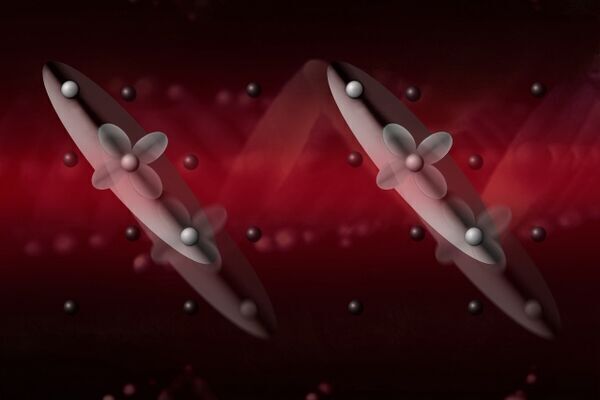
Dancing electrons solve a longstanding puzzle in the oldest magnetic material
"Physicists use extreme infrared laser pulses to reveal frozen electron waves in magnetite. Magnetite is the oldest magnetic material known to humans, yet researchers are still mystified by certain aspects of its properties. For example, when the temperature is lowered below 125 kelvins, magnetite changes from a metal to an insulator, its atoms shift to a new lattice structure, and its charges form a complicated ordered pattern. This extraordinarily complex phase transformation, which was discovered in the 1940s and is known as the Verwey transition, was the first metal-insulator transition ever observed. For decades, researchers have not understood exactly how this phase transformation was happening. According to a paper published March 9 in Nature Physics, an international team of experimental and theoretical researchers discovered fingerprints of the quasiparticles that drive the Verwey transition in magnetite." [...]

New universal carrier ink for 3D printing
"Researchers at ETH have produced a gel from cellulose fibres and biodegradable nanoparticles that liquifies when pressed through the nozzle of a 3D printer, but then quickly returns to its original shape. Their invention paves the way for personalised biomaterial implants. In the same way that medicine has seen a trend towards precision medicine – where treatment is tailored to the genetic make-up of the patient – in recent years, materials scientists are increasingly turning their attention to precision biomaterials. As things stand, however, personalised implants are still a long way off. “But at the moment, we’re making great progress toward this goal – and learning a lot in the process,” says Mark Tibbitt, Professor of Macromolecular Engineering in the Department of Mechanical and Process Engineering at ETH Zurich. The toothpaste problem Previously, researchers working in the field of precision biomaterials were held back by the fact that they had to develop new [A1] inks for the 3D printer for each application." [...]
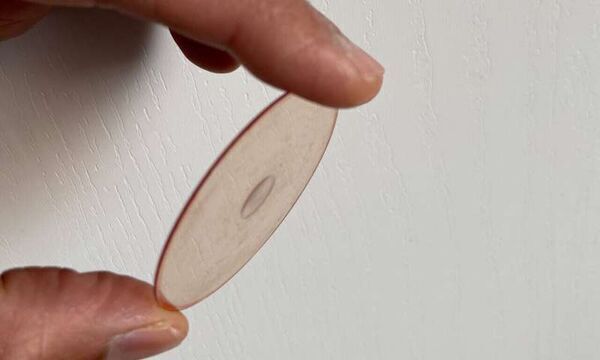
Researchers Create Focus-Free Camera with New Flat Lens
"New technology poised to drastically reduce weight, complexity and cost of cameras while increasing functionality Using a single lens that is about one-thousandth of an inch thick, researchers have created a camera that does not require focusing. The technology offers considerable benefits over traditional cameras such as the ones in most smartphones, which require multiple lenses to form high-quality, in-focus images. “Our flat lenses can drastically reduce the weight, complexity and cost of cameras and other imaging systems, while increasing their functionality,” said research team leader Rajesh Menon from the University of Utah. “Such optics could enable thinner smartphone cameras, improved and smaller cameras for biomedical imaging such as endoscopy, and more compact cameras for automobiles.” In Optica, The Optical Society's (OSA) journal for high impact research, Menon and colleagues describe their new flat lens and show that it can maintain focus for objects that are about 6 meters apart from each other. Flat lenses use nanostructures patterned on a flat surface rather than bulky glass or plastic to achieve the important optical properties that control the way light travels. “This new lens could have many interesting applications outside photography such as creating highly efficient illumination for LIDAR that is critical for many autonomous systems, including self-driving cars,” said Menon." [...]

Discovery points to origin of mysterious ultraviolet radiation
"Billions of lightyears away, gigantic clouds of hydrogen gas produce a special kind of radiation, a type of ultraviolet light known as Lyman-alpha emissions. The enormous clouds emitting the light are Lyman-alpha blobs (LABs). LABs are several times larger than our Milky Way galaxy, yet were only discovered 20 years ago. An extremely powerful energy source is necessary to produce this radiation—think the energy output equivalent of billions of our sun—but scientists debate what that energy source could be. A new study published on March 9 in Nature Astronomy provides evidence that the energy source is at the center of star-forming galaxies, around which the LABs exist. The study focuses on Lyman-alpha blob 6 (LAB-6) whose light was emitted 10.7 billion years ago." [...]

Super magnets from a 3D printer
"Research team develops a method for producing specially designed magnets Magnetic materials are an important component of mechatronic devices such as wind power stations, electric motors, sensors and magnetic switch systems. Magnets are usually produced using rare earths and conventional manufacturing methods. A team of researchers at FAU has worked together with researchers from the Graz University of Technology, the University of Vienna and the research institution Joanneum Research to produce specially designed magnets using a 3D printer. The results were published in the journal Materials. Permanent magnets are incorporated into a number of mechatronic applications. Traditional manufacturing methods such as sintering or injection moulding are not always able to cope with increasing miniaturisation and the resulting geometric requirements for magnets, and this is a trend which is sent to continue in the future." [...]
Projetos Maker
Diversos Projetos interessantes.

Learn 741 op-amp circuits basic with example
"We often see the LM741 circuit in many projects. Sure, You can do them. But… Will it is more fun if you understand how it works? Do not worry at all. I always try to work it easy for you. … Ha..Ha." [...]
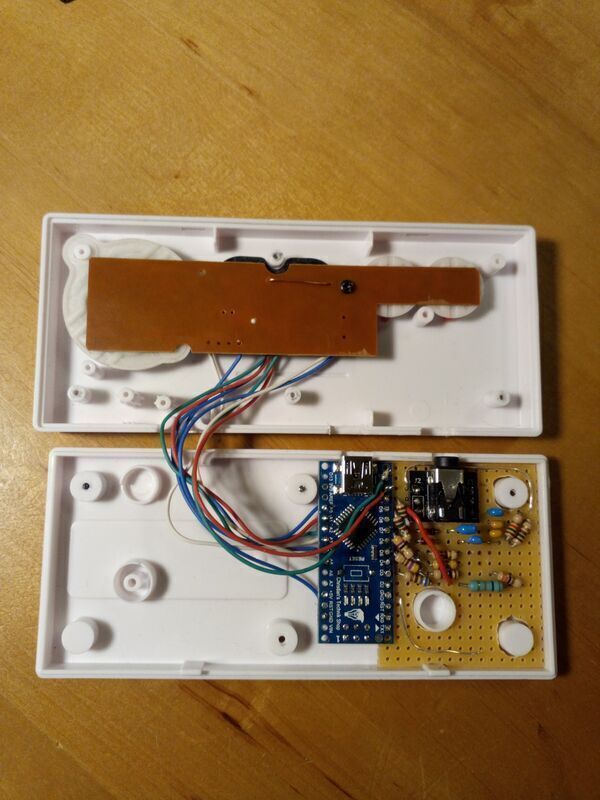
ArduinoGameConsole
"I wanted to build a game console into the case of a small USB game pad (a NES controler look-alike). To make the work a challenge, I wanted to only use an Arduino Nano clocked at 16 Mhz and some passive components (diodes are OK) and create the best possible video and audio signal that is imaginable with such restrictions. As it turned out, a monochrome 288p video signal with 4 gray scales is possible when progamming the controller at machine level. 4-channel music is also possible. My game of choice is Tetris in a version that comes pretty close to the original GameBoy version with a very similar audio track. " [...]
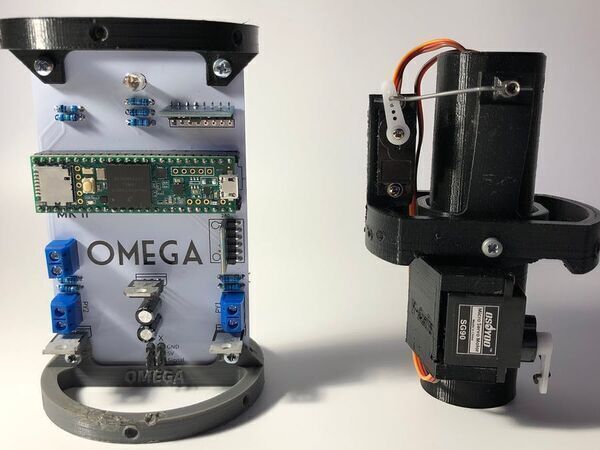
Delta Thrust Vector Control System v8
"This will keep your rocket upright and on course. Hey everyone! Its been 6 months since the original release of the Delta Thrust Vector Control System! Thanks to the help from the community; the TVC mount has gone through three more iterations! Here is a history of the TVC: V1 was a poorly designed 1 axis mount that kinda worked, V2 was much nicer and stronger, V3 improved V2, V4 was the first TVC to include an outer gimbal for two axis control, V5 was the first viable TVC mount for open-sourcing, V6 added linkage stoppers for higher prescion, V7 made V6 stronger and lighter, V8 added functionality for MG-90S and MG-90D servos! Thanks for all of the recent support!" [...]

Wireless Security Camera System with Raspberry Pi & Android
"Turn your Raspberry Pi and old Android phones into a security camera and monitor it from an IoT platform! In this tutorial we will explore how to make a wireless home security camera system using Raspberry Pis and/or old Android phones. This guide will show you how some inexpensive or unused hardware can help watch your back. This project is best used with multiple cameras to help you monitor all areas of your house. There are many tutorials on how to use your Raspberry Pi as a webcam server, but I found this tutorial on Instructables really helpful and easy to follow. They explain the process much better than I can, but any procedure that allows you to view feed my typing in an IP address is good." [...]

SlimPi
"SlimPi is an e-paper display for Logitech Media Servers SlimPi provides an e-paper display for Logitech Media Servers using a Raspberry Pi and e-paper display. My Logitech SqueezeBox has been doing it's job since 2006 when I bought it second hand from e-bay. Come to think of it, I think it might have been the first thing I ever bought from e-bay. In the intervening fourteen years, it has yet to let me down. Unfortunately, the monochrome matrix LED display is getting a bit dim and hard to read. Considering it's been displaying music or the time for over 120,000 hours, I have absolutely nothing to complain about." [...]

Minimal parts simple word clock
"Simple word clock using 2812b leds. This was a project I wanted to do when I saw it on project hub, but using shift registers, external power supply and complicated wiring didn’t allow me to pursue it. When 2812b addressable LEDs became available I was able to reduce the size of the project where my Arduino could power the leds and programming could address them without shift registers. Not having fancy equipment, ie 3d printer, printed circuit manufacturing, etc,, the masking parts are made of cardboard and the LEDs are mounted on cardboard without a printed circuit. The word plate is printed on plain paper however vellum or translucent plastic might be better. The circuit is simple and the size of the project requires no more than 7 LEDs to be on at any given time which allows The Arduino nano to power them." [...]

Giant Remote Controlled Theater Clock
"For the 2020 Brighton High School Musical production of Cinderella, the directors needed a large clock. It needed to be lit from inside and be able to move on cue. The director thought he had another way of doing this, and waited until 2 weeks before opening night to tell me that he didn't have anything. So, I started ordering motors and drivers. The face was cut from six 1/8"x 4'x 8' sheets of white Plexiglass (~$600). Electrical tape was used to add an elegant design that carried a gothic arch motif from other set pieces used in the production." [...]
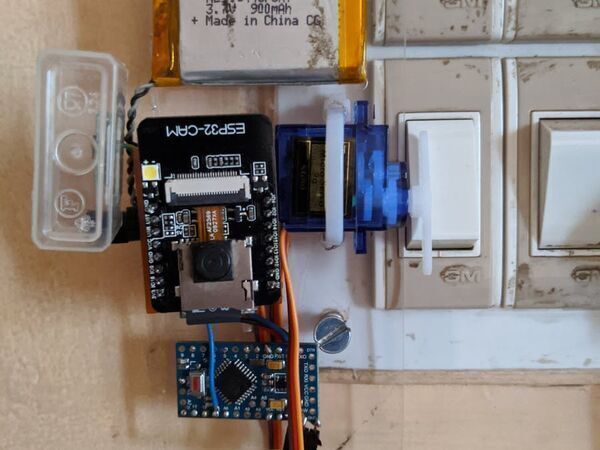
PyroLight
"Smart adaptor for existing switch which gets triggered based on human presence. The word home automation or Smart Home was coined in 1984 by the American Association of House Builders but it was still just a distant dream back then!, Even though the first remote control toy boat was invented back in 1898 by Nikola Tesla. Then in 1975, the first general-purpose home automation network technology X10 was developed. It is a communication protocol for electronic devices. By 2020 its a whopping US$12.81 billion industry. The basic control loop for all these devices is very simple as shown below." [...]
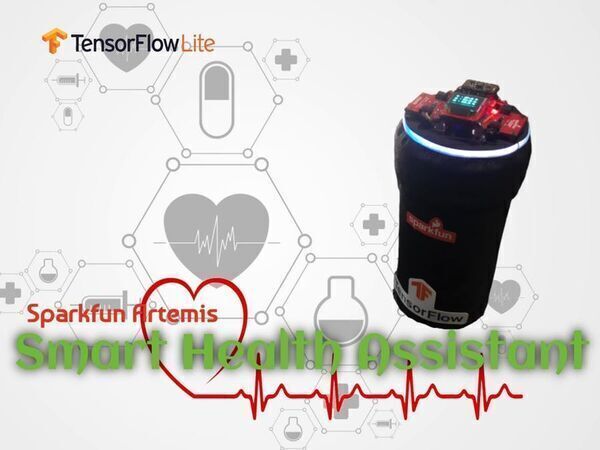
Smart Health Assistant via Sparkfun Artemis
"A smart cardio-health assistant based on Sparkfun Artemis ATP Artemis is the flagship microprocessor module, developed by Sparkfun that will be integrated into the next generation of efficient development boards. Based on Cortex-M4F with BLE 5.0 capability along with 96MHz peak operation, with as low power as 6uA per MHz (less than 5mW). The Apollo3 chip inside each Artemis module can be powered from a single coin-cell battery. The SparkFun Artemis Module is fully FCC/IC/CE certified. Moreover, it provides support for AI/ML development through TensorFlow Lite. Hence, utilizing the capabilities of Artemis ATP(All the Pins) board; with similar form-factor to the famous Arduino MEGA2560, I have developed a Smart Health Assistant that would provide the vital signals associated with cardiac health like Heart-Rate measurement, SPo2 and HRV measurement, Single channel ElectroCardioGram measurement along with ambient environment parameters: temperature, CO2 and TVOCs, humidity and associated altitude, that altogether will be augmented with the captured bio-signals to improve the efficiency and efficacy of the entire system." [...]
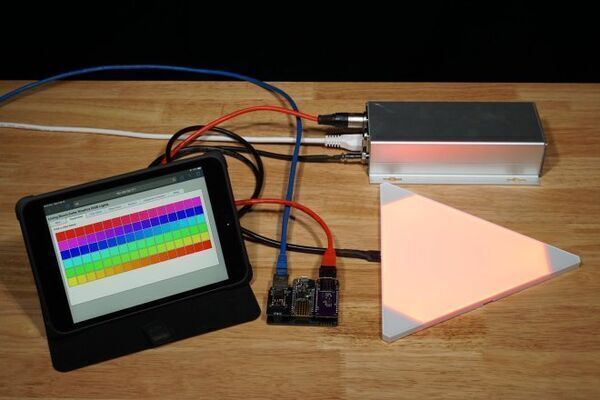
Build a DMX FeatherWing to Control Lights with a Feather M0
"This project uses an Adafruit Feather M0 Basic Proto board to control a group of Color Kinetics or other RGB light fixtures using the DMX-512 protocol. We’ll build a DMX-512 interface FeatherWing then connect it to the Feather M0 using a Particle Ethernet FeatherWing. Once the hardware is built and assembled, we’ll write software with a web-based GUI to generate RGB lighting effects and control the attached RGB lights using the DMX protocol. By modifying the software on the Feather M0, different effects can be generated and added to the web-based GUI. Required Materials The materials required for this project are: DMX FeatherWing board and parts. We’ll discuss ordering the board, the required parts, and the assembly in the next section." [...]
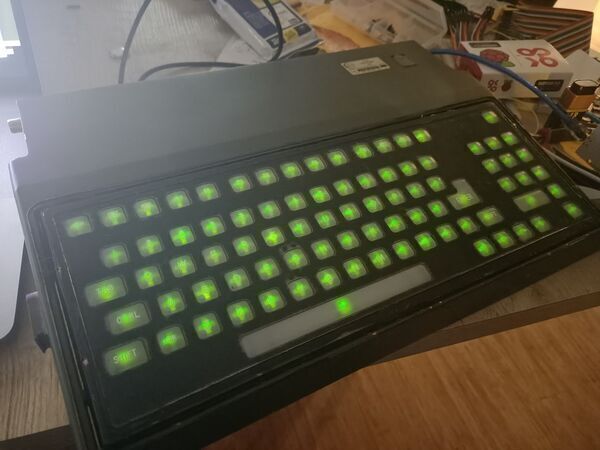
Ex-MoD Keyboard project
"This project has been on the backburner a while.. I originally picked up this AT-02 Marconi / MEDL keyboard a few years ago (2017), did not originally get to far, then jumped back on the project in early 2020. As far as I can see it’s a British military keyboard from 1989, but after a lot of research I could not confirm where it was originally used. It has a few interesting buttons such as: XALM, EW (electronic warfare? ), MSGQ GET, PRNT SUSP, WPNS HOLD. If anyone has any insights as to what this would have been used for, I’d love to know." [...]
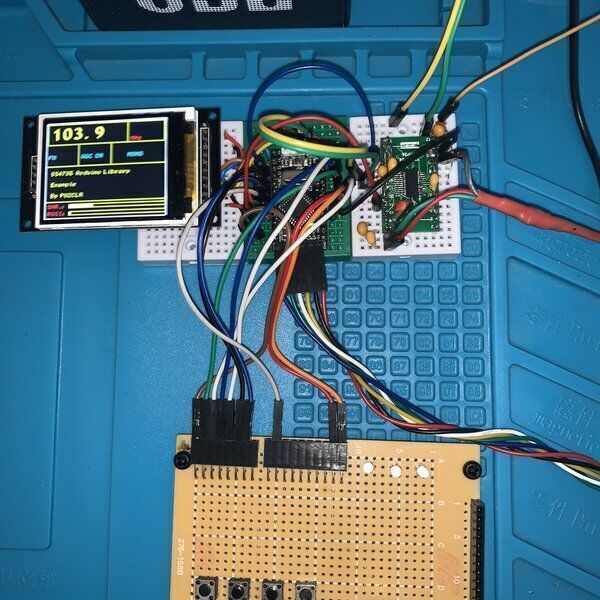
Si4735 SSB Receiver Controlled by Arduino
"Build a complete LW, MW and SW (AM and SSB) radio with the Si4735 and Arduino. It is a receiver based on CI Si4735 controlled by Arduino with SSB support (amateur radio) conetroled by Arduino. This receiver uses the "Si4735 Arduino Library" written by PU2CLR (Ricardo Lima Caratti) and also can be used by others host MCU like (ESP32 and STM32). Features: 1. Encoder to tune stations; 2. Band selection via push buttons 3." [...]
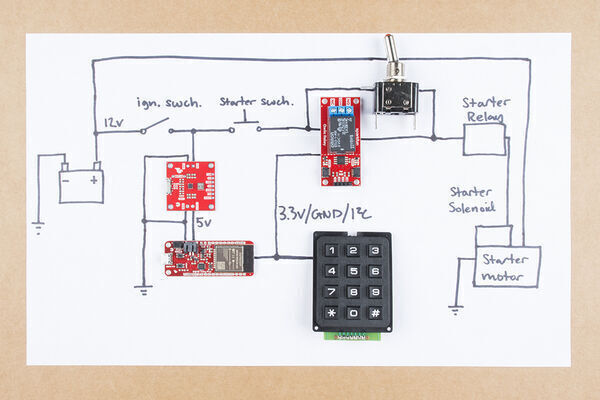
Keycode Security Starter, Part 1
"If you are like me, you enjoy the charm of driving an older vehicle. The mechanical feedback from the car is more organic. You aren’t surrounded by safety and driver aid systems that jump at the opportunity to correct your oh-so human actions. These cars were born in an era when manufacturers strove to have their own look. Shoot, you still get to plug the key into the ignition! You get the point, but as much as the above is appealing, there are many shortcomings in older vehicles, one of the primary being security." [...]
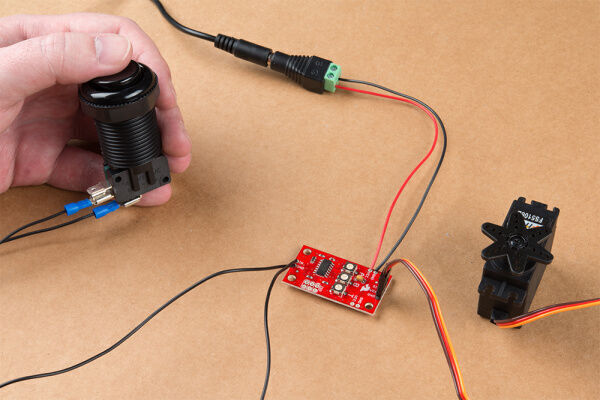
Basic Servo Control for Beginners
"From simply sweeping an object back and forth to adding steering to your robot or R/C car, hobby servos are a great way to add some motion to your next project. Servos allow you to easily control the speed, direction and position [1] of the output shaft with just three wires! This tutorial covers a few different ways to control servos along with a project demonstrating how to control a servo from an external input. We will cover some basics of controlling servos with one example that requires no programming at all. Then we will control the servos with code using the Arduino IDE and Python. Feel free to jump to the example you would like to work with depending on the parts and code environment you prefer." [...]
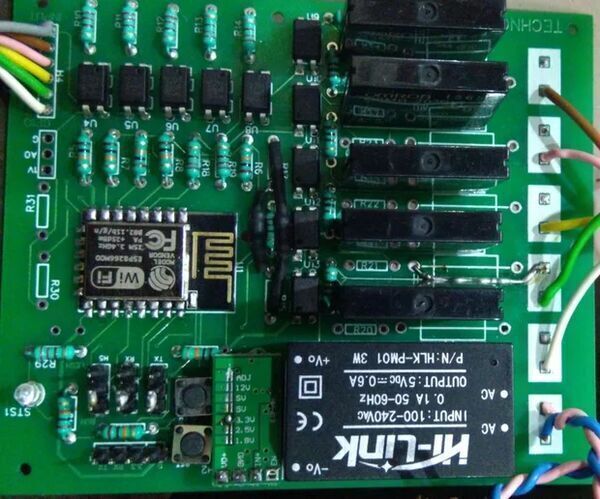
Techswitch 1.0
"Empower Smart home by TechSwitch-1.0(DIY Mode). What is TechSwitch-1.0(DIY Mode) TechSwitch-1.0 is ESP8266 based smart switch. it can control 5 home appliances. Why it is DIY mode?? It is designed to re-flash any time. there is two mode selection jumper on PCB." [...]
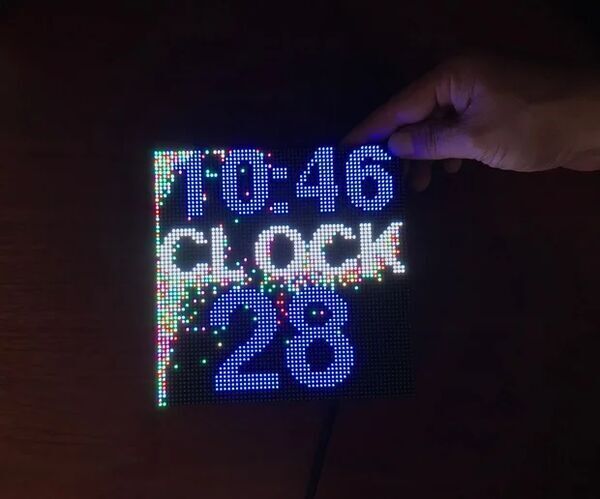
Interactive Internet Clock
"Today, I would like to share how to make an internet clock with interaction effect by P2.5 RGB LED MATRIX 64x64. This clock not only displays the time but also interacts with our motion. It simulates the LEDs as particles of sand and when we interact with clock matrix, particles of sand will move as if they were affected by gravity. Time and motion data are collected and controlled by a MPU6050 (Accelerometer + Gyro) and NODEMCU-32S. Let's get started. Main parts are listed as below: 1pcs x P2.5 64x64 RGB LED Matrix." [...]
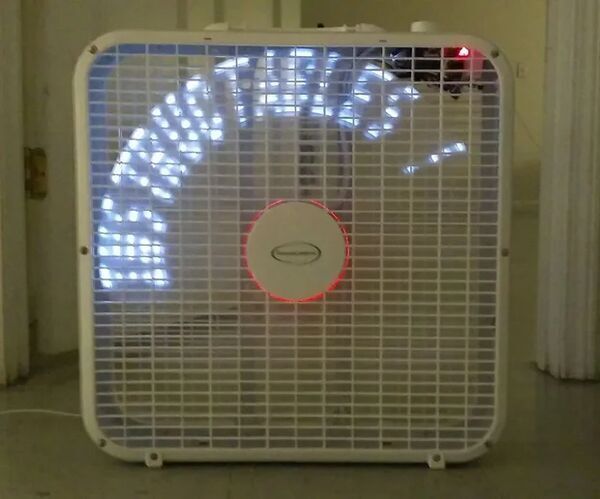
ESP8266 POV Fan With Clock and Web Page Text Update
"This is a variable speed, POV (Persistence Of Vision), Fan that intermittently displays the time, and two text messages that can be updated "on the fly." The POV Fan is also a single page web server that allows you to change the two text messages. To use this POV Fan, there must be a wireless network with "client sharing". If you don't know what client sharing is, it's easy to find out. Look for other computers on your network. If you can see them, you have client sharing capabilities on your network." [...]

DS18B20 Temperature Sensor Box
"Simple DS18B20 based temperature sensor appliance with open source 3D printable box and prototype PCB. The box and the prototype PCB is optional, only one ESP8266 based MCU is needed and one DS18B20 temperature sensor. I suggest to you a WEMOS D1 mini, but this example works with an ESP-01 as well. This example does explain how to write and upload an Arduino program to the ESP8266 MCU, so be aware of this skill before following me. :) Supplies: Must have: - ESP8266 MCU - DS18B20 - one 4.7 kOhm resistor - some wire Optionally have: - WEMOS D1 mini as MCU - prototype PCB for WEMOS D1 mini - 3D printed box" [...]

Browser Interface ATTiny Fuse Editor
"This instructable is for a ATTiny fuse editor using an ESP8266 and a browser based user interface.This makes changing any of the settings controlled by the 2 fuse bytes a very simple activity. The device has the following features: - Web server supporting reading and writing fuse data and an editor page giving easy access to fuse options - USB powered with internal 12V generator for high voltage programming - Header pin interface with the 7 wires needed to connect to an ATTiny module - Wifi network configuratio using wifiManager Access point - Browser access to the ESP8266 SPIFFS filing system for updating web files - OTA update of the ESP8266 firmware Components - ESP-12F module - 5V to 12V boost module - micro USB socket with solderable connector - 220uF Tantalum capacitor - xc6203 3.3V LDO regulator - MOSFET transistors 2x n channel AO3400 1 x p-channel AO3401 - Resistors 2 x 4k7 1x 100k 1x 1K 1x 1R2 - 7 pin header block - Small piece of breadboard for support circuitry - hook up wire - Enclosure ( I used a 3D printed box at https://www.thingiverse.com/thing:4208709) Tools - Fine point soldering iron - Tweezers - Wire cutters" [...]
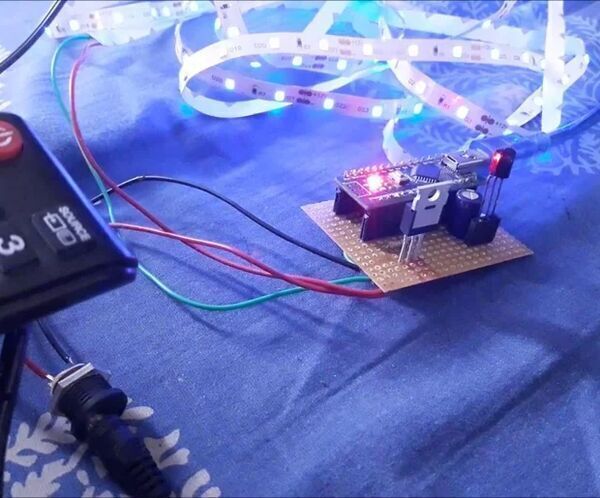
DIY Ir Remote Controlled Led Strip
"Hello hi everyone welcome to our new instructables as you already know from the thumbnail that in this project we're going to make an Ir led strip controller which can be controlled using any commonly available IR remote which are generally used in TV. Etc...hope you will like my instructables...." [...]

Best Oscilloscope Arduino
"Oscilloscope made using the Arduino and OLED 0.96 “display i2c. The oscilloscope has 4 buttons: the first is used to switch between options, the next two are used to change the value smaller / larger, the fourth button freezes the measurement. Main specifications Vertical sensitivity (full width value)Fixed range: 50 V, 20 V, 10 V, 5 V, 2 V, 1 V, 0.5 V, 0.2 V.The wave shape is available as large as possible.Automatically adjusts the upper / lower limit value) ・ Level range (value per div, 4 div = full scale)50ms, 20ms, 10ms, 5ms, 2ms, 1ms, 500us, 200usRising / falling edge detection function.Voltmeter function the voltage value is shown on the display (upper right corner).Turning on the screen lock to keep the screen and then re-enabling the connection to release the lock. When paused, it appears on the screen as paused. " [...]

Linux Powered USB TableClock
"Linux Power USB Table clock is Raspbian Lite Linux powered table clock. It is made to be used especially by night owls like me who want to see a quick time but it's too bright LCD to check the time on a mobile phone. Its look cool on my setup Supplies: Raspberry Pi Zero Waveshare 3.5 inch Display Micro-USB Cable SD-Card" [...]
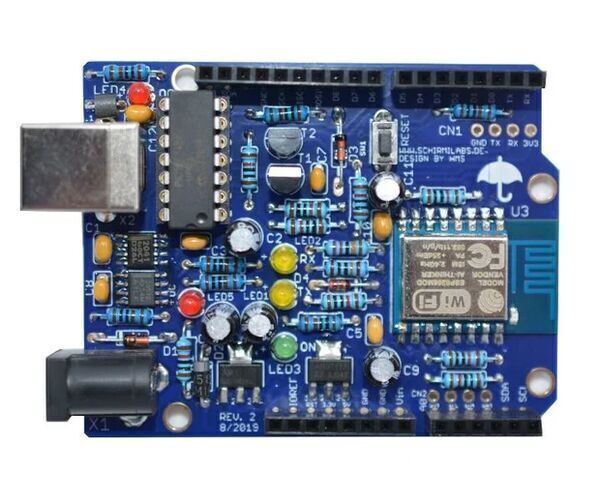
Eduino WiFi
"Eduino WiFi is a DIY Arduino UNO compatible WiFi development board based on the ESP8266EX. I have designed it to teach children soldering, electronics, programming and to build IOT enabled devices. One design goal was to keep the board as simple as possible to solder. For absolute beginners I pre-assemble the SMT parts. The board is supported by the ESP8266 project on github: https://github.com/esp8266/Arduino You can download the project files from here: https://github.com/schirmilabs/Eduino-WiFi If you want to know more about my work: There is an arcticle from our local newspaper Features 11 digital input / output pins. All pins support interrupt, PWM, I2C one-wire (except for D0) 1 analog input (3.2V max." [...]
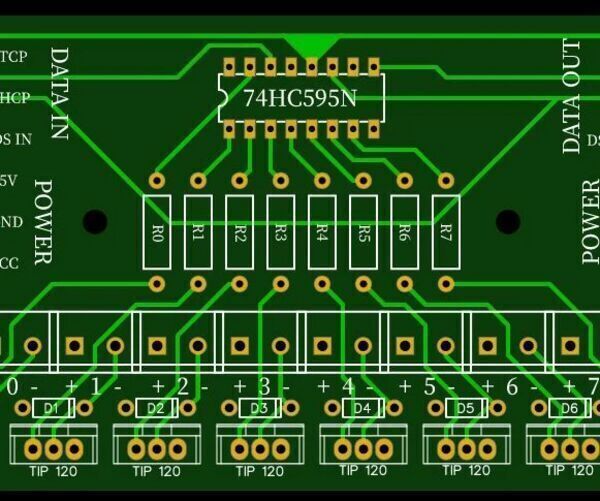
Use 3 Arduino Pins to Control As Many Devices As You Want !
"This is a simple project that will allow you to control as many devices as you want with only 3 GPIO pins on a microcontroller ! " [...]
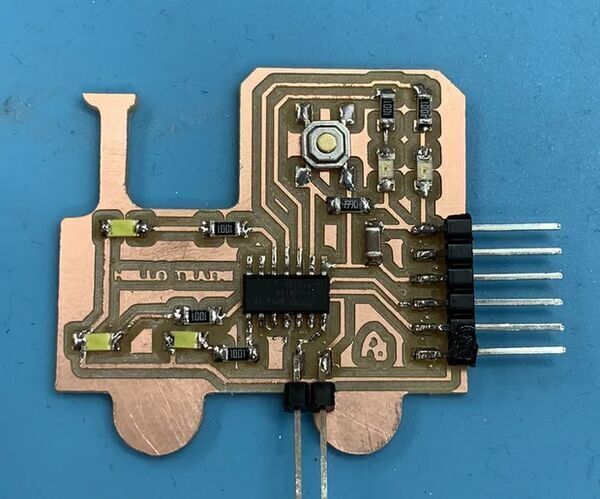
Hello Train! ATtiny 1614
"For my Fab Academy class I have to create a board with a microcontroller, a button and a LED. I will use Eagle to create it. I will use the ATtiny 1614, so I will use the reference of the echo Hello Board ATtiny 1614 from Neil Gershenfeld. I will also design the board with a cool shape, I want to make a train machine. I'm looking for the pinning of ATtiny 1614 because I'm going to need it to know where the pins are. " [...]
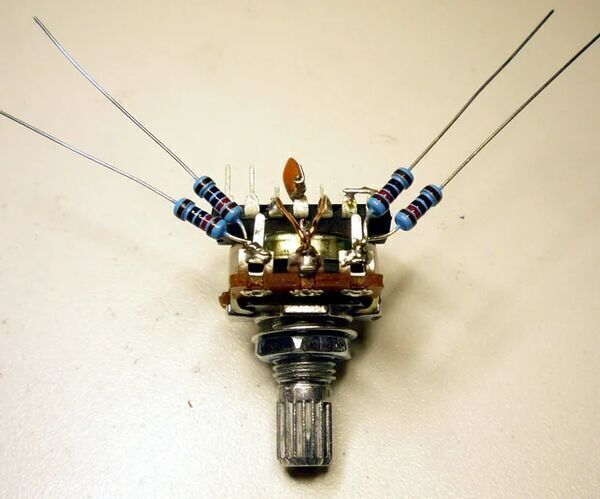
Crossfader Circuit Point-to-Point
"This is a crossfader circuit. It accepts two inputs and fades between them, with the output being a mix of the two inputs (or just one of the inputs). It's a simple circuit, very useful, and easy to build! It does invert the signal going through it, so you won't be able to use it for control voltages. Supplies: Here's what you'll need: 1 potentiometer, 20K will work best, but you can get away with anything from 5K to 100K 4 10K resistors 1 20K resistor 1 100nF ceramic disc capacitor 1 TL074 quad op amp Various wires for power and stuff Pliers to bend stuff Clippers to cut wires A soldering iron and solder A desire to become a soldering ni" [...]
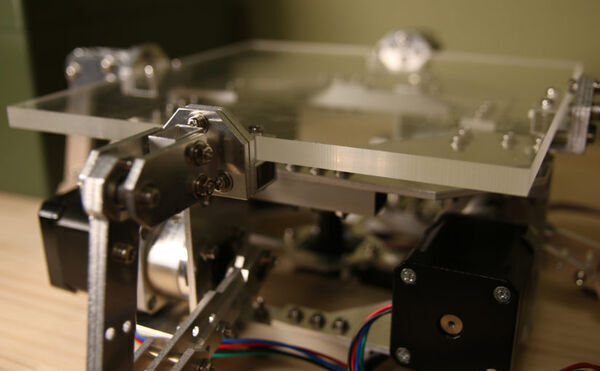
The Octo-Bouncer
"I started thinking about ball juggling machines in the year 2015. I wrote about my first few attempts at creating them in this blog post from the year 2017. In 2018 I wrote another post about my then newest build. We’re now in the year 2020. And finally, the quest to get a machine to juggle a ping pong ball reliably has come to an end (as this current build is able to keep the ball bouncing for hours.) Components This machine requires the following things to work: 1x Teensy 4.0 Microcontroller running this code 4x StepperOnline DM442S stepper motor drivers 4x Nema 17 Stepper Motors with 5:1 planetary gearbox 1x 48V 8A power supply 1x e-con Systems See3CAM_CU135 camera 1x Windows Computer with OpenCV installed on it All the parts defined in this Fusion360 project This custom Windows Application (made with Unity)" [...]

The Watchman
"Designed face structure to securely package electronics and allow quick access. Integrated Google’s AIY Vision Hat for offline face tracking. Added batteries for mobile use. Wrote Python and C++ programs to find faces and direct servo positions. Adapted and upgraded eye mechanism – using Will Cogley’s (Nilheim Mechatronics) advanced eye mechanism. Designed laser accuracy tuning hardware – integrated lasers to tune eye mechanism accuracy." [...]
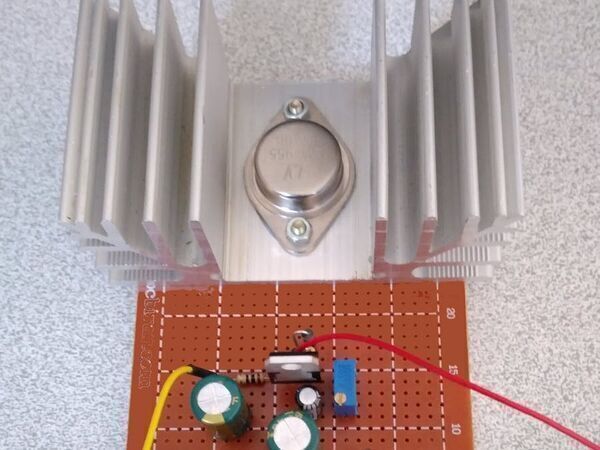
LM317 Current Boosting Secrets!
"LM317 Current Boosting Secrets! LM317 is one of the most popular adjustable regulator chips. The output voltage of the regulator can be adjusted from 1.25V to 35V. However, the chip can deliver currents up to 1.5A which is not enough for some power applications. In this article, I will discuss two methods of LM317 current boosting, using power PNP and NPN pass transistors. [A] Circuit Analysis According to the LM317 datasheet: “The LM317 [1, 2] device is an adjustable three-terminal positive-voltage regulator capable of supplying more than 1.5 A over an output-voltage range of 1.25 V to 37 V. It requires only two external resistors to set the output voltage." [...]

Z80 Arduino Using Mega as Debugger
"Ever since the 80's I've wanted to build a Z80 computer. I even bought the chips, but never used them. The reasons for this are varied. I never liked erasing and reprogramming EPROMs. My EPROM eraser died. I didn't have the money to make a PCB, or the software (or red and blue tape and a lightbox)." [...]
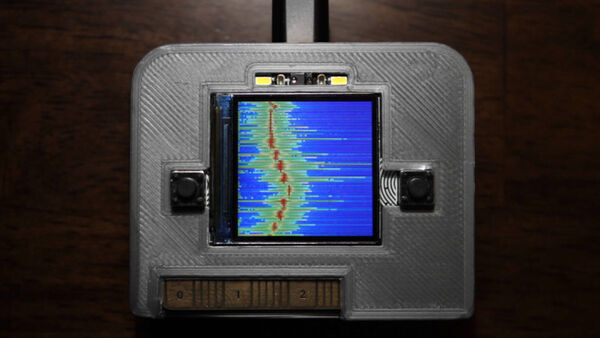
ulab: Crunch Numbers fast in CircuitPython
"What is ulab ulab (pronounced "micro lab") lets you perform number crunching tasks in CircuitPython more quickly, often around 10x as fast. This can be very handy when dealing with sensor data, as we'll see below. Right now, you need to get the "absolute newest" version of CircuitPython to have ulab enabled. It'll be in the stable version no sooner than when 5.1.0 is released. ulab is modeled after numpy, but is not entirely compatible; so after the examples, we'll also provide you with some guidelines to help you move between numpy and ulab. ulab is not available in Blinka, Adafruit's Single Board Computer layer for CircuitPython - for those boards we recommend using plain numpy since its available!" [...]

Sentinel
"Sentinel was designed to provide a subtle reminder not to touch your face. It is very important to avoid touching your eyes, mouth, and nose to prevent the spread of infectious disease. However, this tends to be very difficult to remember through the course of the day. In fact, trying to avoid touching our faces often serves only to remind us just how frequently we do touch them. Sentinel was designed to provide a subtle reminder not to touch your face. When your hand approaches your face too closely, a red light will appear in your peripheral vision in time to modify behavior." [...]
That's all Folks!



